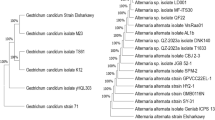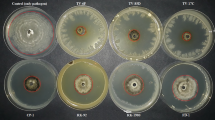Abstract
Postbloom fruit drop (PFD) caused by Colletotrichum acutatum affects flowers and causes early fruit drop in all commercial varieties of citrus. Biological control with the isolate ACB-69 of Bacillus subtilis has been considered as a potential method for controlling this disease. This study aimed to develop and optimize a B. subtilis based-formulation with a potential for large-scale applications and evaluate its effect on C. acutatum in vitro and in vivo. Bacillus subtilis based-formulations were developed using different carrier materials, and their ability to control PFD was evaluated. The results of the assays led to the selection of the B. subtilis based-formulation with talc + urea (0.02 %) and talc + ammonium molybdate (1 mM), which inhibited mycelial growth and germination of C. acutatum. Studies with detached citrus flowers showed that the formulations were effective in controlling the pathogen. In field conditions, talc + urea (0.02 %) provided 73 % asymptomatic citrus flowers and 56 % of the average number of effective fruit (ANEF), equating with fungicide treatment. On the contrary, non-treated trees had 8.8 % of asymptomatic citrus flowers and 0.83 % ANEF. The results suggest that B. subtilis based-formulations with talc as the carrier supplemented with a nitrogen source had a high potential for PFD control.






Similar content being viewed by others
References
Agustí M, Zaragoza S, Bleiholder H, Buhr I, Hack H, Klose R, Staub R (2002) The BBCH scale for describing phenological stages in citrus development. Proc Int Soc Citric 9:445–446
Alí NI, Siddiqui LA, Shaukat SS, Zaki MJ (2001) Survival of Pseudomonas aeruginosa in various carriers for the inhibition of root rot-root knot disease complex of mungbean. Phytopathol Mediterr 40:108–112
Amer GA, Utkhede RS (2000) Development of formulations of biological agents for management of root rot of lettuce and cucumber. Can J Microbiol 46:809–816
Bettiol W, Garibaldi A, Migheli Q (2000) Bacillus subtilis for the control of powdery mildew on cucumber and zucchini squash. Bragantia 56:281–287
Brown AE, Sreenivasaprasad S, Timmer LW (1996) Molecular characterization of slow-growing orange and Key Lime anthracnose of Colletotrichum from citrus as C. acutatum. Phytopathol 86:523–527
Cañamás TP, Viñas I, Torres R, Usall J, Solsona C, Teixidó N (2011) Field applications of improved formulations of Candida sake CPA-1 for control of Botrytis cinerea in grapes. Biol Control 56:150–158
Carvalho ALU, Oliveira FHPC, Mariano RLRM, Gouveia ER, Souto-Maior AM (2010) Growth, sporulation and production of bioactive compounds by Bacillus subtilis R14. Braz Arch Biol Technol 53:643–652
Ciampi-Guillardi M, Baldauf C, Souza AP, Silva-Junior GJ, Amorim L (2014) Recent introduction and recombination in Colletotrichum acutatum populations associated with citrus postbloom fruit drop epidemics in São Paulo, Brazil. Phytopathology 104:769–778
Cray JA, Connor MC, Stevenson A, Houghton JDR, Rangel DEN, Cooke LR, Hallsworth JE (2016) Biocontrol agents promote growth of potato pathogens, depending on environmental conditions. Microb Biotechnol 9:330–354
El-Hassan SA, Gowen SR (2006) Formulation and delivery of the bacterial antagonist Bacillus subtilis for management of lentil vascular wilt caused by Fusarium oxysporum f. sp. Lentis. J Phytopathol 154:148–155
Goes A (1995) Podridão floral de frutos cítricos: Caracterização do agente causal, Colletotricum gloeosporioides Penz. (Sensu Arx, 1957), e controle da doença. PhD thesis in Plant Pathology. p 143. Piracicaba: Escola Superior de Agricultura Luiz de Queiroz. Universidade de São Paulo
Goes A, Garrido RBO, Reis RF, Baldassari RB, Soares MA (2008) Evaluation of fungicide applications to sweet orange at different flowering stages for control of post-bloom fruit drop caused by Colletotrichum acutatum. Crop Protect 27:71–76
Haggag WM, El Soud MA (2012) Production and optimization of Pseudomonas fluorescens biomass and metabolites for biocontrol of strawberry grey mould. Am J Plant Sci 3:836–845
Hamid M, Siddiqui IA, Shaukat SS (2003) Improvement of Pseudomonas fluorescens CHA0 biocontrol activity against root-knot nematode by the addition of ammonium molybdate. Lett Appl Microbiol 36:239–244
Instituto Brasileiro de Geografia e Estatística (IBGE) (2015) Indicadores IBGE, Estatística da produção agrícola, julho de 2015. Online publication. ftp://ibge.gov.br/Producao_Agricola/Fasciculo_Indicadores_IBGE/estProdAgr_201502.pdf
Kim PI, Bai H, Bai D, Chae H, Chung S, Kim Y, Park R, Chi Y (2004) Purification and characterization of a lipopeptide produced by Bacillus thuringiensis CMB26. J Appl Microbiol 97:942–949
Kinay P, Yildiz M (2008) The shelf life and effectiveness of granular formulations of Metschnikowia pulcherrima and Pichia guilliermondii yeast isolates that control postharvest decay of citrus fruit. Biol Control 45:433–450
Klein MN, Silva AC, Lopes MR, Kupper KC (2013) Application of microorganisms, alone or in combination, to control postbloom fruit drop in citrus. Trop Plant Pathol 38:505–512
Köhl J, Postma J, Nicot P, Ruocco M, Blum B (2011) Stepwise screening of microorganisms for commercial use in biological control of plant-pathogenic fungi and bacteria. Biol Control 57:1–12
Kuenpech W, Akarapisan A (2014) Biological control of anthracnose disease in Lady’s Slipper using Bacillus subtilis isolate B6. Sci J Microbiol 2014:1–4
Kupper KC, Gimenes-Fernandes N (2002) Isolation and selection of Bacillus spp. for biocontrol of Colletotrichum acutatum on Tahiti’ lime detached flowers. Summa Phytopathol 28:292–295
Kupper KC, Gimenes-Fernandes N, Goes A (2003) Controle biológico de Colletotrichum acutatum, agente causal da queda prematura dos frutos cítricos. Fitopatol Bras 28:251–257
Kupper KC, Bellotte JA, Goes A (2009) Controle alternativo de Colletotrichum acutatum, agente causal da queda prematura dos frutos cítricos. Rev Bras Frutic 31:1004–1015
Kupper KC, Corrêa EF, Azevedo FA, Silva AC (2012) Bacillus subtilis to biological control of postbloom fruit drop caused by Colletotrichum acutatum under field conditions. Sci Hortic 134:139–143
Lee SC, Yoo JS, Kim SH, Chung SY, Hwang CW, Joo CH, Choi YL (2006) Production and characterization of lipopeptide biosurfactant from Bacillus subtilis A8-8. J Microbiol Biotechnol 16:716–723
Leggett M, Leland J, Kellar K, Epp B (2011) Formulation of microbial biocontrol agents—an industrial perspective. Can J Plant Pathol 33:101–107
Lima WG, Spósito MB, Amorim L, Gonçalves FP, Melo Filho PA (2011) Colletotrichum gloeosporioides, a new causal agent of citrus post-bloom fruit drop. Eur J Plant Pathol 131:157–165
Lopes MR, Klein MN, Ferraz LP, Silva AC, Kupper KC (2015) Saccharomyces cerevisiae: a novel and efficient biological control agent for Colletotrichum acutatum during pre-harvest. Microbiol Res 175:93–99
McGovern RJ, Seijo TE, Hendricks K, Roberts PD (2012) New report of Colletotrichum gloeosporioides causing postbloom fruit drop on citrus in Bermuda. Can J Plant Pathol 34:187–194
Melin P, Hakansson S, Schnurer J (2007) Optimisation and comparison of liquid and dry formulations of the biocontrol yeast Pichia anomala J121. Appl Microbiol Biotechnol 73:1008–1016
Moretto KCK, Gimenes-Fernandes N, Santos JM (2001) Influence of Trichoderma spp. on Colletotrichum acutatum mycelial growth and morphology and on infection of ‘Tahiti’ lime detached flowers. Summa Phytopathol 27:357–364
Ozaktan H, Bora T (2004) Biological control of fire blight in pear orchards with a formulation of Pantoea agglomerans strain Eh 24. Braz J Microbiol 35:224–229
Schisler DA, Slininger PJ, Behle RW, Jackson MA (2004) Formulation of Bacillus spp. for biological control of plant diseases symposium: the nature and application of biocontrol microbes: Bacillus spp. 94:1267–1271
Schmidt CS, Lorenz D, Wolf GA, Jager J (2001) Biological control of grapevine dieback fungus Eutypa lata II: influence of formulation additives and transposon mutagenesis on the antagonistic activity of Bacillus subtilis and Erwinia herbicola. J Phytopathol 149:437–445
Shifa H, Gopalakrishnan C, Velazhahan R (2015) Efficacy of Bacillus subtilis G-1 in suppression of stem rot caused by Sclerotium rolfsii and growth promotion of groundnut. Int J Agr Environ Biotechnol 8:111–118
Sid-Ahmed A (2003) Effect of chitin on biological control activity of Bacillus spp. and Trichoderma harzianum against root rot disease in pepper (Capsicum annuum) plants. Eur J Plant Pathol 109:633–637
Spadaro D, Gullino ML (2005) Improving the efficacy of biocontrol agents against soil borne pathogens. Crop Prot 24:601–613
Teixidó N, Torres R, Viñas I, Abadias M, Usall J (2011) Biological control of postharvest diseases in fruit and vegetables. In: Protective cultures, antimicrobial metabolites and bacteriophages for food and beverage biopreservation ed. Lacroix, C. pp. 364–402. Cambridge: Woodhead Publishing Series in Food Science, Technology and Nutrition n. 201
Timmer LW, Peres NA (2015) Where have all the flowers gone? Postbloom fruit drop of citrus in the Americas. J Citrus Pathol 2:1–6
Timmer LW, Zitko SE (1996) Evaluation of a model for prediction of postbloom fruit drop of citrus. Plant Dis 80:380–383
Vreeland RH, Rosenzweig WD, Powers DW (2000) Isolation of a 250 million-year-old halotolerant bacterium from a primary salt crystal. Nature 407:897–900
Wiyono S, Schulz DF, Wolf GA (2008) Improvement of the formulation and antagonistic activity of Pseudomonas fluorescens B5 through selective additives in the pelleting process. Biol Control 46:348–357
Yánez-Mendizábal V, Viñas I, Usall J, Torres R, Solsona C, Abadias M, Teixido N (2012) Formulation development of the biocontrol agent Bacillus subtilis strain CPA-8 by spray-drying. J Appl Microbiol 112:954–965
Yu GY, Sinclair JB, Hartman GL, Bertagnolli BL (2002) Production of iturin A by Bacillus amyloliquefaciens suppressing Rhizoctonia solani. Soil Biol Biochem 34:955–963
Zulfiqar M, Brlansky RH, Timmer LW (1996) Infection of flower and vegetative tissues of citrus by Colletotrichum acutatum and C. gloeosporioides. Mycol 88:121–128
Acknowledgments
We thank the National Council for Scientific and Technological Development—CNPq—(Proceeding No. 471065/2011-0 granted to Katia C. Kupper) for the financial support and FAPESP (The State of São Paulo Research Foundation) for the scholarship granted to Mariana N. Klein (Proceeding No. 2009/12854).
Author information
Authors and Affiliations
Corresponding author
Rights and permissions
About this article
Cite this article
Klein, M.N., da Silva, A.C. & Kupper, K.C. Bacillus subtilis based-formulation for the control of postbloom fruit drop of citrus. World J Microbiol Biotechnol 32, 205 (2016). https://doi.org/10.1007/s11274-016-2157-6
Received:
Accepted:
Published:
DOI: https://doi.org/10.1007/s11274-016-2157-6




